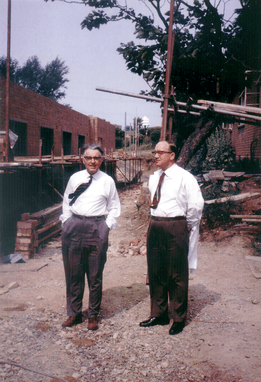Louis Harold Gray facts for kids
Quick facts for kids
Louis Harold Gray
|
|
|---|---|

LH Gray (left) and J Boag supervising construction of the Gray Laboratory at Mount Vernon Hospital in north London.
|
|
| Born | 10 November 1905 |
| Died | 9 July 1965 (aged 59) |
| Education | |
| Known for | Bragg–Gray cavity theory Gray (unit) |
| Spouse(s) | Frieda Marjorie Picot |
| Parents |
|
| Awards |
|
| Scientific career | |
| Institutions |
|
| Thesis | (1930) |
| Doctoral advisor | James Chadwick |
| Author abbrev. (botany) | |
Louis Harold Gray (November 10, 1905 – July 9, 1965) was an English physicist. He spent his career studying how radiation affects living things. He was one of the first scientists to work in the field of radiobiology, which is the study of radiation's effects on biological systems.
Among his many important achievements, Gray helped define a way to measure how much radiation a living thing absorbs. This measurement unit was later named the gray in his honor. It is now a standard unit used around the world.
Contents
Louis Harold Gray's Career and Discoveries
Louis Harold Gray made many important contributions to science, especially in understanding radiation. His work helped improve medical treatments like cancer treatment.
Early Work and Key Equations
In 1933, Gray started working as a hospital physicist at Mount Vernon Hospital in London. This was an important step in his career.
By 1936, he developed the Bragg–Gray equation. This equation is a fundamental tool for measuring how much energy is absorbed by materials when they are exposed to gamma rays. It helps scientists understand how radiation interacts with different substances.
Neutron Research and RBE
In 1937, Gray built an early neutron generator at Mount Vernon Hospital. This machine allowed him to create and study neutrons, which are tiny particles found in atoms.
Using this generator, he began studying the biological effects of neutrons in 1938. This research was crucial for understanding how different types of radiation affect living cells.
In 1940, Gray developed the idea of RBE, which stands for Relative Biological Effectiveness. RBE helps compare the damage caused by different types of radiation. For example, it shows that neutrons can cause more damage than X-rays, even at the same dose.
Focus on Cancer Treatment
In 1952, Gray started research into cells in hypoxic tumors. These are tumors that have low oxygen levels, which can make them harder to treat with radiation. He also looked into using hyperbaric oxygen, which involves giving patients oxygen under high pressure, to help make tumors more sensitive to radiation.
In 1953, he founded the British Empire Cancer Campaign Research Unit in Radiobiology at Mount Vernon Hospital. This unit later became the Cancer Research Campaign’s Gray Laboratory in 1970, and then the Gray Cancer Institute in 2001. This laboratory became a leading center for radiation research.
Discovery of the Hydrated Electron
From 1953 to 1960, under Gray's guidance, a scientist named Jack W. Boag developed a technique called pulse radiolysis. This method uses very short bursts of radiation to study fast chemical reactions.
In 1962, Ed Hart and Jack Boag used pulse radiolysis at the Gray Laboratory to discover the hydrated electron. This was a major breakthrough! The hydrated electron is a very reactive particle that plays a key role in how radiation affects water and biological tissues. This discovery opened up new areas of research that are still important today, especially for understanding how radiation works in cancer treatment.
See also
 In Spanish: Louis Harold Gray para niños
In Spanish: Louis Harold Gray para niños

